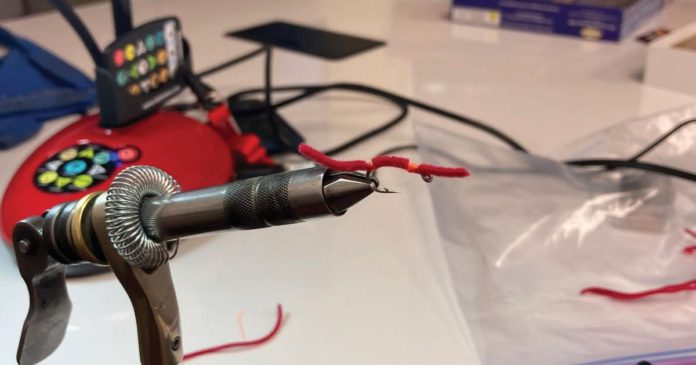SHERIDAN — Whether its peacock feathers or synthetic thread, beads or fur on a glinting fish hook, there is nothing like a beautiful fly-fishing fly. Learning to tie your own flies, however, might be easier than you think.
Flies are meant to imitate the food, particularly insects and invertebrates, fish are interested in eating, renowned fly fisherman, instructor and guide Bob Krumm explained during his recent EveningPlus+ fly tying course at Sheridan College.
The most important aspect of a fly is, of course, its ability to catch fish, Krumm said. Although some flies are unsuccessful in catching fishermen — they don’t feature the bright beads or feathers necessary to impress experienced fly-tyers — most flies will catch fish, Krumm reassured his students.
Fly-tyers choose to tie their own flies for several reasons. Koby Campbell, an associate at Fly Shop of the Bighorns, said he enjoys the practice as a way to get excited — and prepared — for peak fly-fishing season in the spring, summer and fall. Although fly fishers can find thawed fishing holes near Sheridan County year-round, Campbell said Wyoming winters can nonetheless offer few opportunities for fishing on water that’s not frozen. Campbell passes lazy winter Sundays tying flies and awaiting peak season.
Similarly, Campbell explained tying his own flies is a great way to relax. Kent Andersen, a lifelong fly-fisher and Krumm’s co-instructor in the Sheridan College fly-tying class, agreed. One of Andersen and Krumm’s listed goals in the class’ syllabus is to offer students a pursuit to lower stress levels and enhance mental well-being.
“It’s just a really satisfying feeling…[Tying flies] is one place, other than the river, where your mind can just kind of wander,” Campbell said.
Finally, some fly-tyers use their craft to express themselves. Krumm said he found his artistic talent in fly-tying. Now, tying flies offered him an outlet for artistic expression.
“Fly-tying, to me, is an art form,” Krumm said.
Krumm presented a few fly-tying essentials, including bobbins of thread, fishing hooks and scissors, to his Sheridan College class. Some of the more specialized essentials, Krumm explained, include a bobbin-holder, specialized knotting tool called a whip finish and fly-tying vise, a contraption to hold the hook still while tying a fly.
More advanced ties can also involve hackles, or animal product applied to the hook, which can include moose and rabbit hair to synthetic materials to all kinds of bird feathers.
For new fly-tyers, Campbell said many of these materials can be found in fly-tying kits. Krumm, too, supplied his students at Sheridan College with kits to start their expedition into fly tying.
“A kit is a really great place to start,” Campbell said.
YouTube, Campbell said, is also an exceptional resource for new fly-tyers. The website features thousands of tutorial videos with step-by-step instructions on how to tie different flies, many of which are uniquely crafted to mimic certain types of insects and for use during particular seasons. These tutorials can help new or experienced fly tyers discover and practice new patterns, Campbell said.
And practice is essential, Trout Unlimited Little Big Horn Chapter President and avid fly fisher John Madia said. Madia recommended students of a particular fly pattern practice it 12 times during their first attempt at the fly. The practice, Madia said, allows fishing folks to improve and refine their tying of the pattern while filling up the tackle box.
From there, the only remaining step is to wade into a stream and start using those self-tied flies.
“It’s kind of a thrill to catch a fish on a fly that you’ve tied yourself,” Andersen said.
Credit: Source link






























